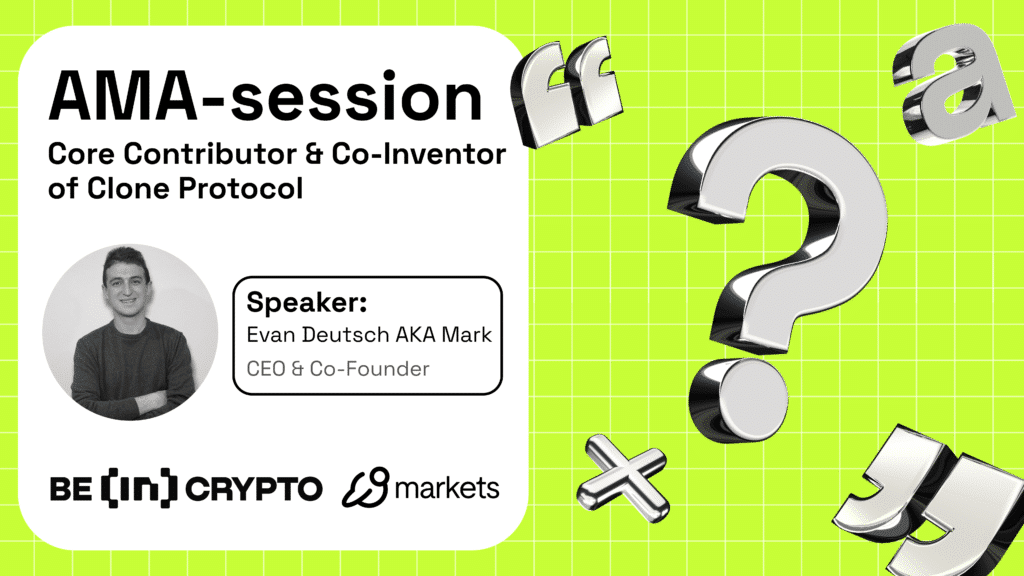Clone Protocol X AMA session with BeInCrypto

Welcome to another exciting AMA session hosted by BeInCrypto! Today, we're joined by a visionary in the DeFi space, Evan Deutsch, as well as Mark, a core contributor and co-creator of the Clone Protocol.
Enter the world of cloned assets and learn how Clone Protocol is providing pioneering solutions to improve liquidity and bridge gaps in the decentralized financial ecosystem.
Mark will share insights into innovative business processes on Clone DEX and examine Clone's technical merits in comparison to traditional DeFi platforms. Learn directly from the source about the creation of cloned assets, their benefits and how to improve your trading strategies.
With $20 available online for five of the community's most intriguing questions, the stakes are high, and the learning potential is high. Get ready to better understand how the Clone Protocol uses the Solana blockchain to transform cross-chain trading and liquidity. get started!
AMA Session with Clone Protocol
BIC: It's AMA time 🔥
Our guest today is Evan Deutsch, AKA Mark, a core contributor and co-creator of the Clone Protocol.
🗣 Community
As usual, I have some questions for Mark and then he answers 5 very interesting questions (quick note: we've already collected these questions)!
These 5 lucky community members will receive $20
Let's start with the simple questions that arise when you hear about clAssets (cloned assets). what are they And how does the trading process work on your Clone DEX?
Mark:
Great question, cloned assets are synthetic derivatives designed to bring liquidity to non-native tokens on Solana.
Classes are backed by our unique Comet Liquidity System (CLS), but trading them is as easy as it gets. Simply exchange USDC for any hedged asset at Clone Markets, our dedicated, savvy front desk for traders.
Currently, we list cloned Arbitrum, cloned Optimism, cloned Sue and cloned Dogecoin. Clone is currently the only marketplace available to trade these tokens on Solana, and we will be moving to new markets soon.
BIC: And what are the technical advantages of using Clone compared to existing DeFi solutions?
Mark:
Solutions allows anyone to bundle tokens and bring them into the Solana ecosystem. These bridged properties have very infrequent liquidity at Solana, and even infrequent utility.
This problem is not unique to Solana, it is very difficult in the crypto space to move and use tokens between chains.
We believe the future is multichain, and crypto needs a scalable, sustainable solution to this problem. Clone, and our protected assets, are that solution.
Our DEX has the power to bring liquidity to non-native tokens without the need for bridging, and our highly efficient liquidity model allows us to rapidly scale into new non-native token markets.
BIC: Can you explain the process of creating a hedged asset? 👀 What are the steps involved?
Mark:
One interesting quality of CLS is that our comet fluid positions, or more simply “comets”, are cross-border. This means that LPs can provide liquidity to each classet pool at the same time using only USDC!
Because of this, creating a new closed-end asset is incredibly easy, we build instructions into our smart contracts to add the new pool, and LPs can immediately allocate liquidity without having to move any capital.
Each classet has a trusted literal value (we use PYTH) and a trusted bridge property (we use deBridge or Wormhole) to ensure that the property is secure and stable.
BIC: 🔥 Why did you choose Solana blockchain?
Mark:
Our goal has always been to build a DEX that can provide an efficient, scalable solution to the bridge asset liquidity issue. When it comes to efficiency and scalability, we don't see a better option than Solana. Also, since Solana is not based on EVM, it is more difficult to bridge liquidity to many popular tokens.
We've been building on Solana since 2021, it's been a rollercoaster, but we've stayed committed to what we believe is the most powerful blockchain in the world.
BIC: Ok, I believe this question will be interesting for our community 🙌.
How can Clone help crypto traders improve their trading strategy? What are some real world examples of how Clone can be used to gain an edge in the market?
Mark:
By bringing non-native token liquidity to Solana using claAssets, we are making it possible to trade any token with incredibly low transaction fees and fast execution speed on a fully decentralized platform.
Additionally, closed assets open up other business options in Solana DeFi, one example being funding rate farming.
I wrote an article on this, but in short you can develop a perp funding volume by establishing a profitable position on the perp DEX and an opposite position on the Clone. All this can be done without leaving Solana.
BIC: How do you see Solana's role in trading any chain from any chain using Clone Protocol classets?
Mark:
As I mentioned, we believe Solana is the most powerful blockchain in the world, and we're passionate about making the chain reach its full potential.
Why should Solana maxis be the only one to enjoy the benefits of Solana's low transaction cost and speed?
By making any token available to use and trade on Solana, the chain will be the most capital-efficient decentralized platform for trading any token.
Many people agree that the future is multichain, but in that multichain future, we believe that many traders will flock to Solana, and because of Clone, they can trade any token.
BIC: How many clones are currently available on the clone market? 🤔
Mark:
There are currently 4 tokens: claARB, clOP, clSUI and clDOGE. And we'll be adding more quickly!
BIC: Okay, what about ‘comets'? What are they in the context of the Clone Liquidity platform? ☄️
Mark:
Comets are the name of our special liquid space. They have unique features such as being fully funded by USD, cross-border and leveraged.
These special places are very flexible and efficient, but can be a little complicated for newcomers. Clone Liquidity's “Comet” section is specifically designed to make managing your Comet as easy as possible.
Comets, and CLS, allow us to quickly scale into new closed asset markets.
BIC: Can you provide step-by-step instructions on how users can create tokens and provide liquidity on Clone Liquidity? 🦾
Mark:
of course! There are really only 2 easy steps.
Step 1: Add a holding in USDC to your Comet.
Step 2: Add liquidity to as many pools as you want, with the leverage of your choice!
It is important to understand each of your comet fluid positions, especially the health effect and ILD (Irregular Loss Liability).
The health point measures the threat level of your position, if it reaches 0, you can be liquidated.
ILD is the liability you owe based on losing your status, which can negatively impact your health score so it's important to keep track.
BIC: I like short instructions 😁
How can users borrow against secured assets? Who is this feature good for?
Mark:
Borrowing on Clone requires 250% more leverage, and can be useful for shortening or matching classes. Most users do not need to use the borrow function on Clone Liquidity.
If you want to borrow/lend foreclosed properties, using our Clone pool on Solund is almost always more capital!
BIC: A mandatory question for all our AMA sessions 🤷🏻♀️
What steps does Clone Protocol take to address potential risks associated with flash lending attacks and other security vulnerabilities in the DeFi space?
Mark:
We audit in Halborn, but as we all know, auditing is not enough to guarantee safety.
Every day our team spends time finding vulnerabilities and “hacking” our own platform. We understand the responsibility that DEX must take, and each of us is 100% committed to putting ourselves in the shoes of a hacker and plugging any vulnerabilities.
BIC:
How does the cloner community influence the development of Clone DEX? Can you explain the decision-making process in the Clone Protocol management model? How will token holders participate and influence proposals or changes to the protocol?
Mark:
Nothing is more important to us than our clone community, they guide every decision we make. For example, many of the changes to our frontend, partnerships/promotions, and new curated property listings are ideas that come directly from our community.
We haven't launched a token yet, but a significant part of the usage will be for administration.
BIC: In what ways is Clone Protocol pushing the boundaries of what is possible in the Solana DeFi ecosystem, and what challenges are you aiming to overcome?
Mark:
We're building a new product from scratch to solve a problem no one else has tried to solve. We understand that many crypto users are frustrated with the bridge experience and the lack of funds for related assets, especially Solana, and we are committed to solving this problem.
We are excited to usher in the new era of values where anyone can use any token from any chain in the Solana DeFi ecosystem.
BTW, does Clone integrate with any popular DeFi wallets or platforms?
Mark:
We have announced partnerships/integrations with key platforms such as Pit, DeBridge and Solland.
This is just the beginning, there are many amazing projects on Solana, and together we will create an amazing Solana community. If we get the chance to work with these projects and educate their communities about what Clone has to offer, we're always more than happy to do so.
BIC: Tell us about season 1 of your points program. How can members of our community get involved?
Mark:
It's important to us that $CLN owners are actively using and understanding the product, and that's the goal of the Clone Points program.
Users can prove their contribution and awareness of the protocol through trading, funding, and social engagement through the Zelli campaign.
Participating in the campaign is easy, you can earn points by trading classes on Clone Markets (or providing liquidity using Comets on Clone Liquidity).
We currently have a Trading Points promotion where every trade gets 1.5x points. Also, we launched our first Cloner Classic giveaway where we're giving away 135,000 points to 3 lucky traders. Every dollar you trade earns you a ticket into this random drawing, so anyone starting at $1 can climb to the top of our leaderboard!
BIC: Wow! Community, pay attention to what's coming from Clone!!!
Let's move on to the questions of the community 😏
@ErnestHarbin asks:
In what ways does Clone Protocol solve the challenges associated with cross-chain trading, such as liquidity sharding or interdependence issues?
Mark:
Thanks for asking @ErnestHarbin, let's dive a little deeper into the problem Clone was built to solve.
Liquidity fragmentation, and the general lack of bridge asset liquidity and consumption is a problem not only in Solana, but in the entire crypto space.
The main issues are the high risk/high cost of splitting liquidity across multiple versions of the same asset and the high risk/high cost required to create liquid markets for bridge assets for LPs.
Clone facilitates the efficient introduction of fluids to non-native properties using our purpose-designed cross-comet fluid system.
By removing liquidity from the existing USDC pool and allowing LPs to contribute without having to bridge or use other chains, we facilitate the process of creating non-native asset markets for new assets on Solana using clAssets.
BIC: The second question is by @sondeptrai5.
How does the hybrid collateral model contribute to maintaining price caps and efficient market operations for assets in the Clone Protocol ecosystem?
Mark:
Great question @sondeptrai5!
A hybrid bond model allows users to exchange bridging assets for directly bonded assets. For example, a cloned arbitrum can be swapped 1:1 with a debridge arbitrum at any time. This creates an arbitrage opportunity whenever asset prices fall, and ensures that they are always closely tied to their non-native counterparts.
BIC: @LittleXiaYuann:
What is Funding Rate Farming, and how does it enable traders to get delta-neutral yields on Clone and perpetual exchanges like Drift?
Mark:
Thanks @LittleXiaYuann for this question, let's talk more about how traders can use cloned assets for farm funding.
Funding Rate Farming allows traders to profit from currency fluctuations in the peso exchange using delta neutral positions. Perp exchanges on Solana, like Drift, often have users who are long assets paying users who are funded if the rate is positive and short if the rate is negative.
A trader can buy a hedged asset, say claARB, and short ARB on Drift when the funding rate is positive. This delta-neutral position earns you a percentage of Drift funding, and income on both Clone and Drift.
BIC: @StefanSisco:
What opportunities does the Clone Pool integration on Solend offer users, particularly in capital efficiency and business strategies related to clAssets?
@StefanSisco Glad you brought this up!
Our Clone Pool on Solend allows users to borrow/borrow collateralized assets alongside SOL and USDC. This pool of funding can be used to make rate agriculture more capital efficient.
Following our last example, after buying claARB, the trader can use cARB as collateral to borrow USDC or SOL from our Solend pool. They can then use that USDC or SOL to build their actual position on Drift to multiply the financing amount. This is one useful application of Solund Pool.
BIC: Last question by @ToryCody.
Can you discuss Clone Protocol's vision for democratizing finance, revolutionizing liquidity solutions and promoting mass adoption of Solana in liquid non-native asset markets?
Mark:
From the beginning, my co-founder Ku and I have been passionate about democratizing financing and investment opportunities.
We believe DeFi is the best place to achieve this goal, and Solana is the best home for DeFi in terms of capital efficiency and speed.
We saw a problem hindering Solana's growth, the lack of liquidity for non-native tokens, and we designed Clone to solve this problem.
Pooled assets will not only enrich Solana Defy, but also make the Solana ecosystem more accessible by allowing you to trade tokens you know. Using packaged assets, we plan to help Solana achieve mass adoption and drive financial democracy forward.
Final thoughts
As we wrap up this AMA session with Evan Deutsch, we hope you've gained valuable insights into the Clone Protocol and the changing landscape of DeFi. The opportunities with assets locked on the Solana blockchain are strong, offering huge opportunities for liquidity and cross-chain business efficiency.
Don't forget to explore Clone Markets and try the trading strategies discussed today. Stay tuned to BeInCrypto for more updates and future AMAs that will continue to bridge the gap between technology and practical application in Crypto.
Disclaimer
This article is sponsored content and does not represent the views or opinions of BeInCrypto. While we adhere to The Integrity Project's guidelines for impartial and transparent reporting, this content was created by a third party and is intended for promotional purposes. Readers are advised to independently verify information and consult with experts before making decisions based on this sponsored content. Please note that our terms and conditions, privacy policies and disclaimers have been updated.













